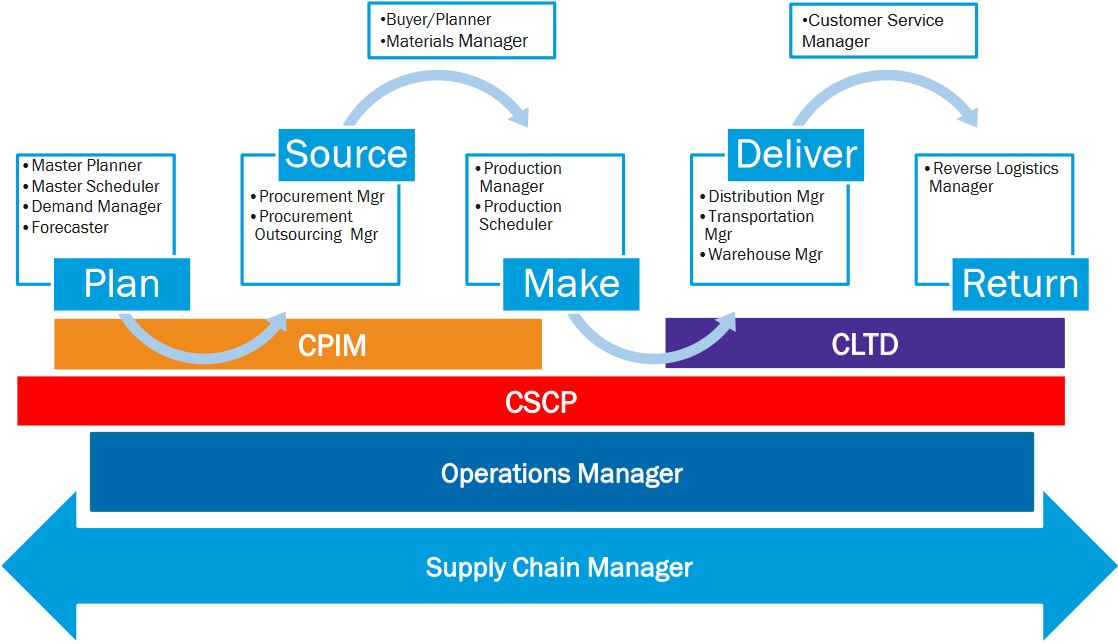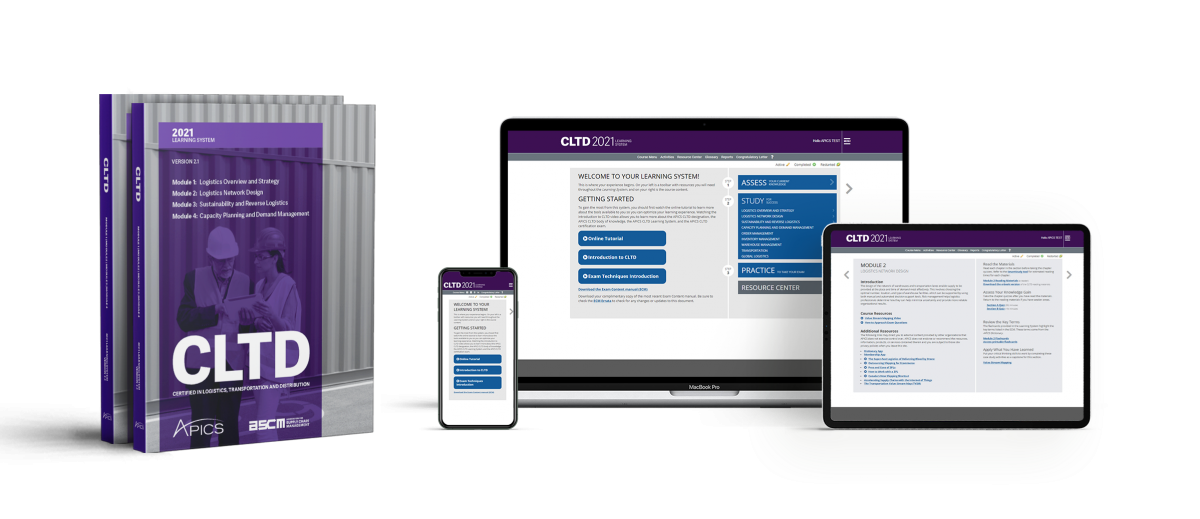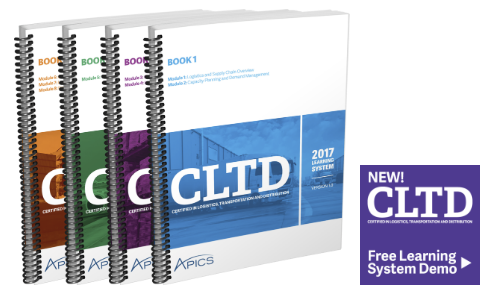The APICS Certified in Logistics, Transportation and Distribution (CLTD) designation assess individuals based on a comprehensive body of knowledge, best practices and standards for those in the logistics, transportation and distribution industries. The certification was introduced late in 2016 and is designed to address the Deliver and Return processes of the SCOR framework as indicated in the diagram below.

The APICS CLTD Learning System is a comprehensive professional development and exam preparation program. It consists of eight reading modules and interactive, web-based study tools that reflect the new APICS CLTD Exam Content Manual (ECM). This program provides a comprehensive body of knowledge and standards for those in the logistics, transportation and distribution industries. Each module will further empower you with an understanding of best practices, knowledge and skills necessary to maximize your organization’s efficiency and impact the bottom line.
The courseware has been divided into 8 modules as follows :-
Module 1 - Logistics and Supply Chain Overview
- Managing logistics as a cohesive system
- Understanding tradeoffs to present a logistics strategy that aligns with the organizational strategy
- Finding the most effective mix of revenue producing services for the cost of providing that service
- Developing strong relationships across the supply chain
- Designing key performance indicators to encourage desired behaviors
- Using continuous improvement to exceed customer expectations
Module 2 - Capacity Planning and Demand Management
- Understanding the concepts behind forecasting and its application to logistics decisions
- Creating efficient forecasts to better align supply to demand
- Translating demand information into high-level capacity plans for warehousing and transportation
- Collaborating between procurement and logistics
- Understanding key processes, including S&OP, MPS, MRP and DRP
- Delivering customer service at a consistent level
Module 3 - Order Management
- Planning, designing and controlling processes which manage and execute customers’ orders
- Implementing a customer relationship management (CRM) process
- Understanding key logistics systems, such as EDI and TMS to enable visibility throughout the order process
- Tracking and measuring supplier and carrier performance to improve efficiency and effectiveness
- Managing relationships with the supply chain partners
- Developing a customer service management strategy
- Enhancing long-term customer satisfaction and creating lifetime customers
Module 4 - Inventory and Warehouse Management
- Maintaining inventory levels to align with the business strategy and goals, supporting the coordination of supply and demand, while protecting inventory value
- Creating an inventory management strategy that meets competing goals of minimizing inventory costs and maximizing customer service
- Managing the movement of materials and goods into and out of storage efficiently, safely, and with minimal inventory damage
- Adapting to new distribution channels and customer expectations by creating new processes that deliver the desired results
- Implementing efficient and effective warehouse processes, while utilizing appropriate warehouse technology
- Using appropriate packaging to promote safe and efficient materials handling during storage and transportation
Module 5 - Transportation
- Understanding transportation fundamentals, including key stakeholders, intermediaries and carriers involved in transporting product from origin to destination
- Understanding the characteristics of the different transportation modes to make appropriate selections based on speed, availability, dependability, capability, frequency and cost
- Moving goods and services throughout a firm’s supply chain, between where products are produced and where they are consumed, while allowing for competitive growth
- Effectively manage the entire transportation process—from long-range strategies and operational planning to day-to-day execution
- Utilizing transportation technology to manage and control visibility and communication between multiple stakeholders and transportation managers
Module 6 - Global Logistics Considerations
- Identifying macro-environmental factors of global logistics that impact countries and organizations around the world to better manage logistics service providers, related transportation costs, and substitute product offerings
- Working knowledge of international trade theories and practices, including trade agreements and trading blocs
- Understanding the infrastructure, systems and regulations of the countries to which goods are imported/exported
- Understanding customs clearing and documentation requirements for each shipment as dictated by each country and transportation mode used
- Preparing all required documentation needed to ensure shipments arrive safely, securely, without damage, and on time at their final designation
- Using the Harmonized System Classification codes to properly specify the goods for export and dictate the corresponding tariff rates charged
- Identifying which financing and payment options are most appropriate and amenable to the parties involved
- Deciding what currency will be most appropriate for global trade participants, balancing levels of risk exposure between buyers and sellers
Module 7 - Logistics Network Design
- Designing the network of warehouses and transportation lanes to enable supply to be provided at the place and time of demand
- Analyzing transportation and distribution requirements, while understanding key tradeoffs, to assist in planning and deployment of network
- Using decision support tools to determine the optimal number, location, and type of warehouse facilities
- Employing modeling techniques to help find the right balance among competing needs of involved stakeholders
- Implementing risk management strategies to minimize uncertainty and provide more reliable organizational results
- Creating prevention and mitigation plans, as well as providing business continuity if a risk event occurs
Module 8 - Reverse Logistics and Sustainability
- Developing a comprehensive reverse logistics strategy
- Recommending whether the reverse logistics strategy can be handled internally by creating a central returns center or by hiring a third-party provider to coordinate the activities
- Managing product returns in ways that turn the reverse flows into quantifiable value streams, to contribute to profitability and strengthen commitment to sustainability and social responsibility
- Demonstrating social responsibility that is valued by customers, shareholders, and the community, to help the organization be a good environmental steward for the long-term
- Implementing sustainability initiatives to impact the organization’s triple bottom line (TBL)
- Choosing suppliers and other supply chain members according to the organization’s commitment to implement sustainable processes and practices
See also www.learnCLTD.com

As with the CSCP certification, the CLTD requires an eligibility criteria process step before being approved to commence study.
Hilf clients can access the password protected customer area to obtain further CLTD information by viewing a PowerPoint presentation developed by APICS.





